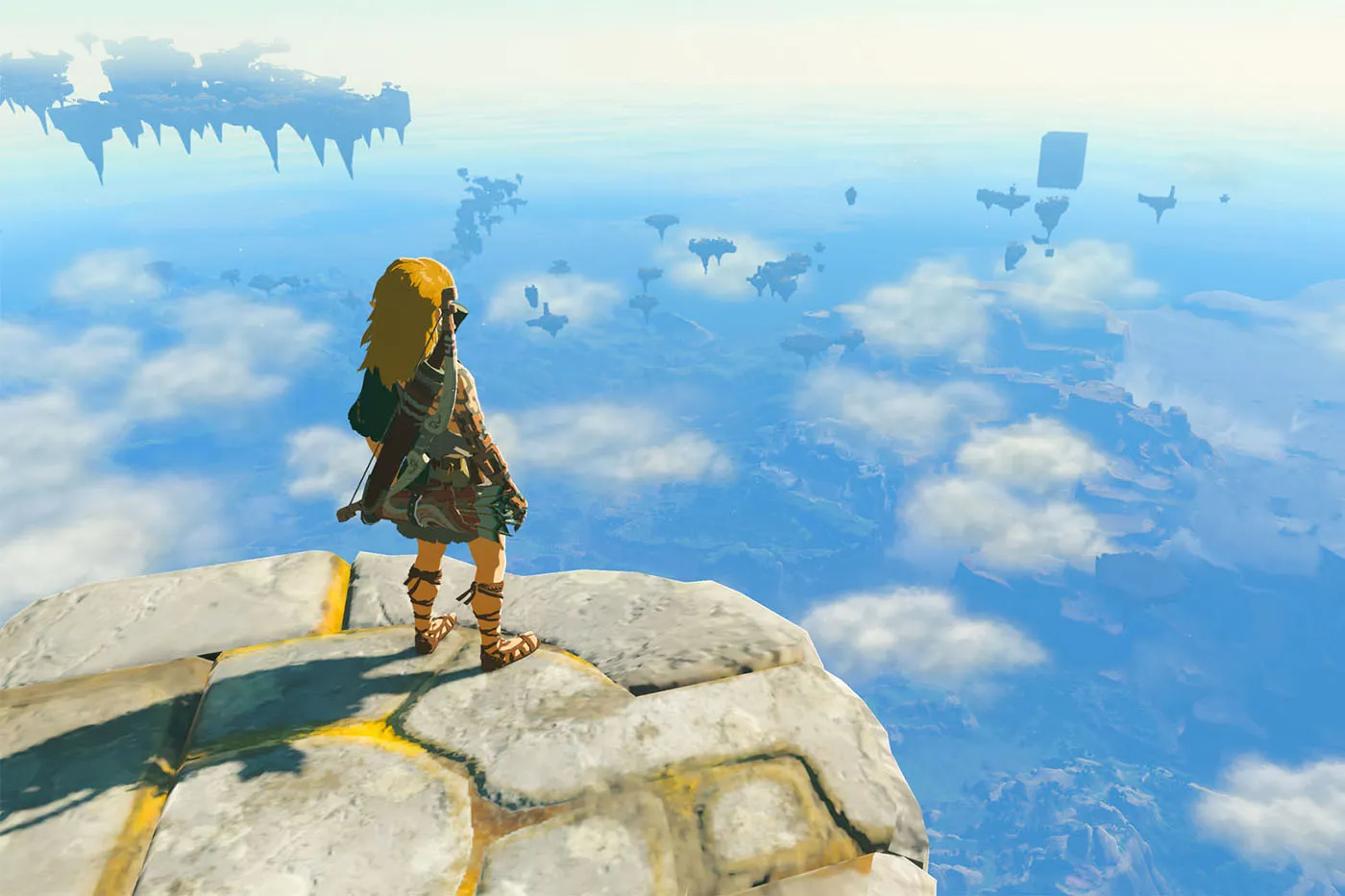Tears of the Kingdom is a masterclass in game design…
“The Legend of Zelda: Tears of the Kingdom,” developed and published by Nintendo, serves as a highly anticipated sequel to the critically acclaimed “Breath of the Wild.” Released in 2023 for the Nintendo Switch, it continues the story of Link and Zelda while introducing new gameplay mechanics and narrative elements that enhance the beloved formula of its predecessor. This review delves into the game’s story and gameplay mechanics, providing a comprehensive look at how “Tears of the Kingdom” builds on and innovates within the framework established by “Breath of the Wild.”
Story and Setting
“Tears of the Kingdom” picks up the narrative threads left dangling at the end of “Breath of the Wild.” The game opens with Link and Zelda exploring the depths beneath Hyrule Castle, where they uncover a mysterious, malevolent force that has been stirring for centuries. This discovery sets off a chain of events that sees Hyrule once again plunged into turmoil. The narrative’s central theme revolves around ancient evils and the cyclical nature of history, a recurring motif in the Zelda series.
The story is richer and more intricately woven than in “Breath of the Wild.” While the previous game relied heavily on environmental storytelling and fragmented memories, “Tears of the Kingdom” presents a more structured narrative without sacrificing player agency. The game balances traditional cutscenes with interactive storytelling, allowing players to uncover the lore at their own pace while maintaining a coherent plotline.
The game world of Hyrule has expanded both horizontally and vertically. The introduction of sky islands, remnants of an ancient civilization, adds a new dimension to exploration. These floating landmasses are not just visually stunning but are also integral to the game’s story and puzzles. The contrast between the ruined, war-torn surface and the serene, mystical sky islands underscores the narrative’s themes of loss and hope.
Gameplay Mechanics
The gameplay mechanics in “Tears of the Kingdom” represent an evolution of the systems introduced in “Breath of the Wild.” The core pillars of exploration, combat, and puzzle-solving are refined and expanded, providing a more immersive and engaging experience.
Exploration
Exploration remains a central component of the game, but “Tears of the Kingdom” introduces new layers to this mechanic. The addition of sky islands and subterranean caverns offers varied environments that require different traversal strategies. Players can use a combination of gliding, climbing, and new abilities to navigate these areas.
One of the standout new abilities is the “Ascend” mechanic, which allows Link to phase through ceilings to reach higher ground. This ability opens up vertical exploration and encourages creative problem-solving. The paraglider, a beloved tool from “Breath of the Wild,” returns with enhancements that make aerial navigation smoother and more dynamic.
The world is teeming with secrets, from hidden shrines and Korok seeds to ancient ruins and treasure chests. The Sheikah Slate has been upgraded to the Purah Pad, offering new functionalities such as a detailed map, camera, and environmental scanner. These tools aid in exploration, making it easier to uncover the game’s many hidden gems.
Combat
Combat in “Tears of the Kingdom” builds on the foundation laid by its predecessor while introducing new mechanics to keep encounters fresh and challenging. The weapon durability system returns but with improvements that address some of the criticisms from “Breath of the Wild.” Weapons now have a slightly longer lifespan, and players can find materials to repair and enhance their favorite armaments.
The introduction of new weapon types and abilities adds depth to combat. For instance, the “Zonai Artifacts,” ancient devices left by the lost civilization, can be integrated into combat for strategic advantages. These artifacts include energy shields, powerful projectiles, and even mechanized companions that can assist in battle.
The enemy AI has been significantly improved. Enemies now exhibit more sophisticated behaviors, coordinating attacks and using the environment to their advantage. This makes battles more engaging and requires players to adapt their strategies on the fly. The addition of new enemy types, including aerial foes that can attack from the sky islands, adds variety and challenge to encounters.
Puzzle-Solving
Puzzles have always been a cornerstone of the Zelda series, and “Tears of the Kingdom” continues this tradition with innovative and challenging designs. Shrines return, offering a mix of combat trials, environmental puzzles, and logic challenges. These shrines are thematically tied to the ancient civilization of the sky islands, blending old and new elements in their design.
One of the most exciting new mechanics is the “Fusions” ability, which allows Link to combine objects in the environment to create new tools and weapons. This mechanic is crucial for solving puzzles and opens up a wide range of possibilities for creative problem-solving. For example, players might fuse a metal box with a balloon to create a floating platform or combine a torch with a spear to light distant braziers.
Dungeons, a much-missed element from “Breath of the Wild,” make a triumphant return in “Tears of the Kingdom.” These dungeons are larger and more intricate than shrines, offering multi-layered puzzles and formidable bosses. Each dungeon is unique, reflecting the environment and lore of its location, and provides significant rewards upon completion.
Graphics and Sound
While this review focuses primarily on gameplay mechanics and story, the visual and auditory elements of “Tears of the Kingdom” significantly enhance the overall experience. The game retains the beautiful cel-shaded art style of “Breath of the Wild” but with noticeable improvements in detail and lighting. The environments, whether the lush forests of Hyrule, the desolate underground caverns, or the ethereal sky islands, are meticulously crafted and visually stunning.
The dynamic weather system and day-night cycle return, adding to the game’s immersive quality. Weather can affect gameplay, with rain making surfaces slippery and thunderstorms posing a threat to those carrying metal equipment. These environmental factors require players to adapt their strategies and planning.
The sound design and musical score are exceptional, as expected from a Zelda title. The soundtrack, composed by Manaka Kataoka and Yasuaki Iwata, builds on the minimalist piano melodies of “Breath of the Wild” with richer orchestrations that reflect the game’s expanded scope. The ambient sounds, from the rustling of leaves to the distant calls of wildlife, create a living, breathing world that draws players in.
Impact and Legacy
“Tears of the Kingdom” not only builds on the success of “Breath of the Wild” but also sets a new standard for open-world games. Its innovative mechanics, engaging story, and richly detailed world offer an experience that is both familiar and refreshingly new. The game’s success is reflected in its sales figures and critical acclaim, cementing its place as one of the defining titles of the Nintendo Switch era.
The game’s impact extends beyond its immediate success. “Tears of the Kingdom” has influenced game design across the industry, with its emphasis on player freedom, environmental interaction, and non-linear storytelling serving as a benchmark for future open-world titles. The introduction of mechanics like Ascend and Fusions has sparked new discussions about creativity and innovation in game design.
Criticisms
Despite its many strengths, “Tears of the Kingdom” is not without its criticisms. Some players have expressed concerns about the weapon durability system, even with its improvements. The need to constantly manage and replace weapons can still feel tedious to some, detracting from the otherwise fluid gameplay experience.
Additionally, while the game’s story is richer and more structured than “Breath of the Wild,” some players may find the narrative pacing uneven. The balance between main quests and side activities can sometimes disrupt the flow of the story, leading to moments where the urgency of the plot feels at odds with the open-world exploration.
Conclusion
“The Legend of Zelda: Tears of the Kingdom” is a masterclass in game design, offering a deeply engaging and richly rewarding experience. Its blend of exploration, combat, and puzzle-solving mechanics creates a game that is both expansive and intimate. The narrative, while building on the foundation of “Breath of the Wild,” adds depth and complexity, making the journey through Hyrule feel both familiar and new.
For fans of the Zelda series, “Tears of the Kingdom” is a must-play, offering a continuation of the beloved saga with innovative twists that enhance the core experience. For newcomers, it provides an accessible yet deeply immersive entry point into one of gaming’s most storied franchises.
In summary, “The Legend of Zelda: Tears of the Kingdom” stands as a testament to the enduring appeal of the Zelda series. It pushes the boundaries of what an open-world game can achieve, combining a compelling narrative with gameplay mechanics that encourage creativity and exploration. Whether you’re soaring through the skies, delving into ancient dungeons, or simply wandering the vast landscapes of Hyrule, “Tears of the Kingdom” offers an adventure that is as captivating as it is unforgettable.


